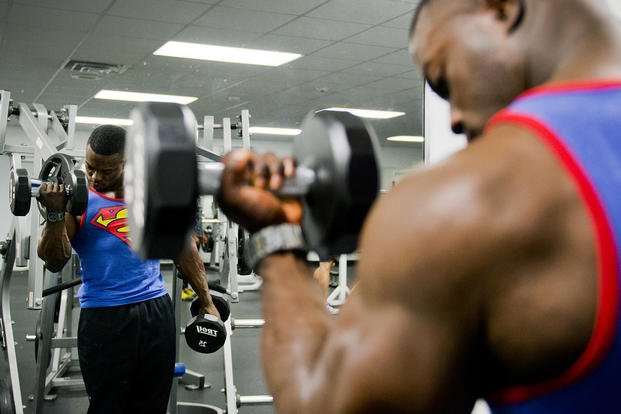Resting between sets of heavy weightlifting, lightweight circuits, running intervals or other cardio events varies in time, depending upon your goal. There typically are five goals various athletes seek when starting a training program: bigger muscles, stronger muscles, muscle stamina, cardiovascular endurance or cardiovascular event speed (run, swim, bike, other).
The amount of rest between events can mean the difference between moderate and optimal gains. Here is a question from a reader seeking to know how much time to rest between sets when not specifically stated:
Stew,
When you write workouts, I notice you do not always like rest periods with weight training sets as you do with running or swimming sets. What do you recommend for rest sets in between weights, circuits, running and swimming if the goals are varied through the year like your periodization training programs?
Bob
Great question, Bob.
The answer depends on your age, conditioning and goals. As we age, we may need more rest between sets of everything in order to recover fully, but that time and type of rest depend on the other two factors (athlete’s conditioning and goals). Here are the types of rest you can use. My recommendation is to try several of them and see what works best for your goals, daily timeline to train and current conditioning.
Types of rest
Active rest is done typically by group training programs where the “rest” is built into workouts by doing other muscle groups immediately after each other. For instance, a circuit where you do pull-ups and then “rest with squats” is a way to recover for the next set when muscle stamina and cardiovascular endurance is the goal. Some running endurance/muscle stamina goal workouts such as run and leg PT can challenge the lungs and legs, adding an active rest of squats, lunges, or stair climbs between running intervals of 400-800 meters.
I prefer active rest in any activity I do. Even with building strength in lifts, I prefer to do some form of easy core activity between sets instead of just sitting in the gym and watching people work out.
Some competitive lifters, who are trying to avoid gaining too much weight or want to lose weight while maintaining strength, may hop on a cardio machine for 3-5 minutes between sets to keep burning calories and recover for the next heavy lift. You typically do not see active rest in optimal performance goals for strength and hypertrophy, but workouts can be adjusted to make the most effective use of time and athletic conditioning as needed.
Inactive rest can be done in all athletic goals and is by far the most common rest type. It means actually doing nothing between sets. Simply walking between sprint intervals, walking to get a sip of water or sitting between lifts are examples of inactive rest. The time depends upon the activity and goal.
- Short rest periods are defined typically as 1-2 minutes (between sets) in the weight-lifting and muscle-growth (hypertrophy) training, with a moderate level of repetitions and weight. Doing repetitions in the 6-12 zone will help you build muscle optimally when done with moderate to heavy weights.
- Longer Rest Periods are 3-5 minutes between sets. You will see this type of rest period when power lifters and heavy weight-training goals (1-5 rep max weight lifted: 1-5RM) are being chased. The three-minute zone is ideal, as it allows for the body to refuel itself and not cool down too much. If you think 3-5 minutes is a long time to rest, try being a sprinter. If a sprinter seeks to increase speed for 50-100 meters, consider resting 30-60 seconds per 10 meters between sets but keep moving.
- Ratio rest depends on the goal as well as the conditioning of the athlete. For instance, if sprinting, an athlete may want to have a rest-to-work ratio of 1:1 if fast-paced endurance is sought or even 2:1 or longer if working on pure sprinting speed. As an example, an athlete seeking to run 400 meters for multiple sets to increase the pace of the 1.5-mile timed run, may strive to rest as long as it took to run or as progress is made to push themselves to rest 50% of the run time. A person running a 1:30 400-meter pace may first start out at 1:30 rest and advance to 45 seconds of rest as improvement in cardiovascular endurance increases.
In the end, it is up to you, your goals and abilities as to what you can do with an active rest or if you need longer periods of inactive rest. The goal is to be recovered as best you can for the next working set. Sometimes staying tired and getting into the condition to handle minimal rest is part of the program goals. That's especially true when the days are long and turn into night, as many of the military selection programs for special operations require.
Stew Smith is a former Navy SEAL and fitness author certified as a Strength and Conditioning Specialist (CSCS) with the National Strength and Conditioning Association. Visit his Fitness eBook store if you’re looking to start a workout program to create a healthy lifestyle. Send your fitness questions to stew@stewsmith.com.
Want to Learn More About Military Life?
Whether you're thinking of joining the military, looking for fitness and basic training tips, or keeping up with military life and benefits, Military.com has you covered. Subscribe to Military.com to have military news, updates and resources delivered directly to your inbox.














